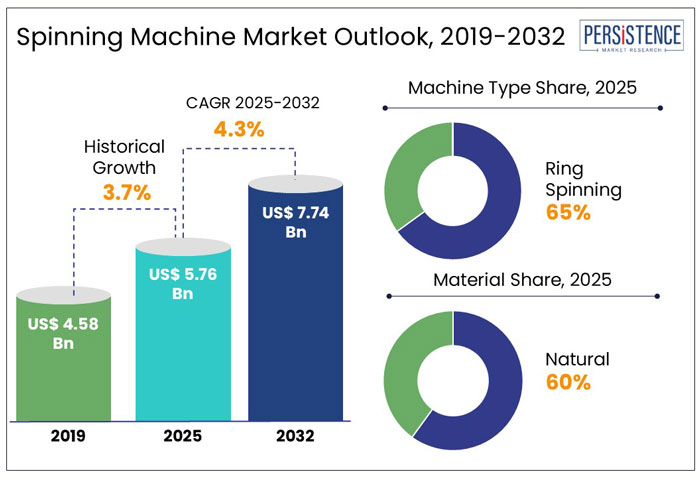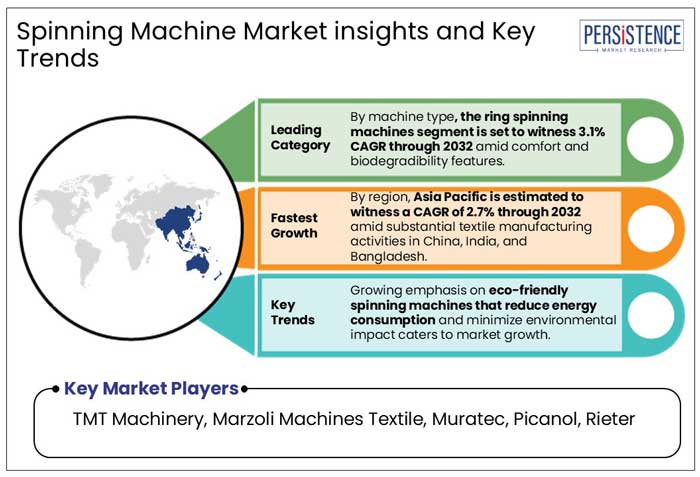Industry: Industrial Automation
Published Date: February-2025
Format: PPT*, PDF, EXCEL
Delivery Timelines: Contact Sales
Number of Pages: 180
Report ID: PMRREP35129
The global spinning machine market size is anticipated to rise from US$ 5.76 Bn in 2025 to US$ 7.74 Bn by 2032. It is projected to witness a CAGR of 4.3% from 2025 to 2032.
The global spinning machine industry has been experiencing steady growth, driven by increasing demand for textiles and developments in manufacturing technologies. The adoption of automatic spinning machines is on the rise, with the segment surpassing US$ 3.6 Bn. Automated machine demand is set to be driven by the need to enhance productivity and reduce manual labor. For example,

Key Industry Highlights
|
Global Market Attributes |
Key Insights |
|
Spinning Machine Market Size (2025E) |
US$ 5.76 Bn |
|
Market Value Forecast (2032F) |
US$ 7.74 Bn |
|
Projected Growth (CAGR 2025 to 2032) |
4.3% |
|
Historical Market Growth (CAGR 2019 to 2024) |
3.7% |
Automation and Digitization Boosted Spinning Machine Adoption across Industries from 2019 to 2024
The global spinning machine market witnessed a steady growth trajectory during the historical period from 2019 to 2024 at a CAGR of 3.7%. This growth was propelled by rising demand for textiles across various industries, including fashion, home furnishings, and industrial applications.
Adopting unique spinning technologies, such as automation and digitalization, was crucial in enhancing production efficiency and product quality. Such innovations enabled manufacturers to meet the evolving needs of the textile industry, leading to increased market penetration.
Spinning Machine Demand to Accelerate with Green Technologies and Smart Automation
The market is projected to reach US$ 7.74 Bn by 2032, reflecting a CAGR of 4.3% through 2032. Growing emphasis on eco-friendly spinning machines that reduce energy consumption and minimize environmental impact further caters to market growth.
Manufacturers are developing machines that absorb less energy and emit fewer greenhouse gases, aligning with global sustainability goals. The market has evolved from a traditional industry to a technologically advanced sector with a strong focus on sustainability and efficiency. The ongoing integration of innovative technologies and the expansion of global textile markets are expected to sustain this growth trajectory in the coming years.
Growth Drivers
Surging Demand for High-quality Non-woven Materials to Augment Market Growth
Increasing application of non-woven fabrics in healthcare, automotive, and construction industries is a significant growth driver for the spinning machinery market. Non-woven fabrics are essential for producing medical masks, wipes, and geotextiles.
Rising demand for non-woven fabrics is primarily driven by increased hygiene awareness and the booming automotive sector. Surging demand necessitates unique spinning machinery capable of efficiently producing high-quality non-woven materials.
High Capital Costs and Energy Consumption Challenge Spinning Machine Adoption
One of the most significant challenges in the spinning machine market is the high capital investment and ongoing maintenance costs associated with innovative textile manufacturing equipment. The expenses can create barriers for Small and Medium Enterprises (SMEs), limiting their ability to adopt new technologies and expand production capabilities.
The cost of setting up a modern spinning facility, including high-end automated spinning machines, ranges from US$ 1 Mn to US$ 10 Mn, depending on capacity and technology. In countries like India and China, subsidies and incentives are being provided to textile companies to adopt modern machinery.
Spinning machines are energy-intensive, with the textile industry consuming around 1.2 trillion kWh of electricity globally yearly. High energy costs further add to the burden, especially in countries where electricity prices are volatile.
Launch of Smart Spinning Machines to Help Reduce Costs and Optimize Yarn Quality
The spinning machine industry is experiencing a transformation driven by technological innovations and automation, presenting a significant growth opportunity. The integration of smart spinning machines, artificial intelligence (AI), and the Internet of Things (IoT) is enhancing efficiency, reducing operational costs, and improving the quality of spun yarns.
As manufacturers seek to boost productivity while minimizing environmental impact, automation is emerging as a key driver for market expansion.
Machine Type Insights
Versatile Ring Spinning Machines to Augment High-quality Yarn Production
Ring spinning machines are favored for their versatility and ability to produce high-quality yarns. They can spin a wide range of fiber types, including natural fibers like cotton and wool as well as synthetic fibers. The segment is anticipated to generate a share of 65% in 2025. For example,
The process involves drawing out the fiber, twisting it to add strength, and winding it up onto bobbins, resulting in delicate, strong, and uniform yarns. The ring spinning method is particularly valued in the textile industry for applications requiring superior yarn quality, such as high-end apparel and delicate fabrics.

Consumer Preference for Breathable Fabrics Strengthens Natural Fiber Demand as Sustainability Trends Rise
Natural fibers, such as cotton, wool, silk, and flax, are preferred due to their inherent qualities like breathability, comfort, and biodegradability, which align with consumer preferences for sustainable and eco-friendly textiles. The segment is projected to hold a share of 60% in 2025.
Cotton is the most commonly spun fiber due to its widespread availability and favorable properties. The enduring popularity of natural fibers in textile production is driven by their versatility and the growing demand for sustainable materials.
Consumers increasingly favor natural fibers over synthetic alternatives, contributing to their dominant position in the spinning machinery market. The trend underscores the industry's commitment to sustainability and the continuous appeal of natural fibers in textile manufacturing.
Investments in Cost-effective Production and Raw Material Availability Propel Asia Pacific
The Asia Pacific spinning machine market leads the global revenue charts, primarily due to the substantial textile manufacturing activities in China, India, and Bangladesh. China alone contributes significantly, with about 30.7% of the total market share of the region. Asia Pacific is anticipated to hold a share of 40% in 2025.
The region's dominance is attributed to its well-established textile hubs, abundant raw materials, and cost-effective labor force. Increased investments in automation and sustainable manufacturing practices enhance production efficiency and reduce environmental impact, which caters to the region's dominance in the spinning machine industry.
Increased Spending on Smart Manufacturing Technologies to Enhance Production Efficiency in North America
The North America spinning machine market focuses on high-quality textile production and the adoption of advanced technologies. The U.S. leads this region, with the market valued at over US$ 1.2 Bn in 2023.
The emphasis in North America is on integrating automation and digital solutions to improve efficiency and meet the growing demand for technical textiles. Recent trends show a shift towards sustainable practices, with manufacturers investing in eco-friendly machinery and processes to align with environmental regulations and consumer preferences.
Implementation of Circular Economy Principles Enhances Sustainability in Europe’s Textile Manufacturing
Europe maintains a significant spinning machine market, with countries like Germany, Italy, and France at the forefront. The region holds a substantial share, contributing to around 25% of the global market in 2025.
A strong commitment to innovation and sustainability complements Europe's rich textile heritage. The adoption of energy-efficient machinery and the implementation of circular economy principles in textile production.
The regional market is also witnessing collaborations between machinery manufacturers and textile producers to develop innovative spinning technologies that enhance productivity and reduce environmental impact.
The spinning machine industry is highly competitive, driven by technological developments, sustainability trends, and automation. A few leading companies in the industry strive to innovate the textile industry with new innovations, mergers and acquisitions and product launches.
Companies increasingly focus on innovative spinning technologies, energy-efficient machines, and sustainable fiber processing to meet evolving market demands. Automation and IoT integration are game changers, enabling predictive maintenance and improved efficiency. Intense competition and ongoing research and development investments shape the industry as companies strive for market leadership through innovation and sustainability-driven solutions.
Key Industry Developments
|
Report Attributes |
Details |
|
Historical Data/Actuals |
2019 - 2024 |
|
Forecast Period |
2025 - 2032 |
|
Market Analysis Units |
Value: US$ Bn/Mn, Volume: As applicable |
|
Geographical Coverage |
|
|
Segmental Coverage |
|
|
Competitive Analysis |
|
|
Report Highlights |
|
|
Customization and Pricing |
Available upon request |
To know more about delivery timeline for this report Contact Sales

The market is set to reach US$ 5.76 Bn in 2025.
Lakshmi Machine Works, Shima Seiki, and TMT Machinery are a few leading players.
The industry is estimated to rise at a CAGR of 4.3% through 2032.
Ring Spun, Rotor-Spun, Twistless, Wrap-Spun, and Core-Spun Yarns are the prime methods of spinning.
The market is anticipated to reach a value of US$ 7.74 Bn by 2032.